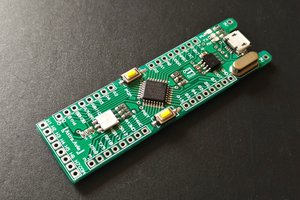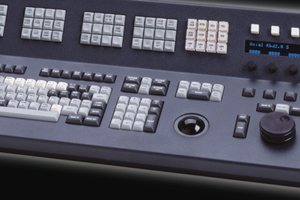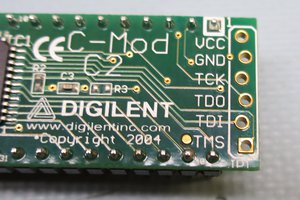Brother AX-100 Typewriter Hacking
Seeing if I can 'get serial' on my grandmothers typewriter.
Seeing if I can 'get serial' on my grandmothers typewriter.
To make the experience fit your profile, pick a username and tell us what interests you.
We found and based on your interests.
AX-100-Photo-Explore.zipLots of photos of th einside of the Brother AX-100, including Keyboard (UK English) layout and connections.Zip Archive - 15.94 MB - 10/09/2019 at 17:01 |
|
Well, I made good progress over the weekend,
First I spent time with al the bits of documentation I have, and the pcb from the typewriter (it's very fine tracked, but single sided, easy to read).
Then I instrumented the PCB with some probe pins to Serial2, and brought them, 5v and Gnd out and refitted the keyboard.
Somewhat unsurprisingly I didn't see any signals at all on either pin, they go low->high at poweron and remain that way.
Having researched stuff I was totally unsurprised, there are no variants of this typewriter with a serial/centronics output, and this board/processor combo does not appear to support any external (non-debug) comms.
Given time constraints I'm going to put this aside now, if it was quick-n-easy I'd have gone further but at this point I'm into interpreting and responding to the 8x8 scan matrix of the keyboard. Quite doable but not on my time budget ;-)
Something earlier and similar is here; the author of this went further than me and has a arduino sketch that sends keystrokes to Brother typewriter of the same era that appears to have the same keyboard setup.
http://numist.net/post/2010/project-typewriter.html
I have some great pictures of the pcb and keyboard track layouts, so I'll upload them up too for reference.
I'll stuff all the useful photos in an archive and upload it for reference.
Note: This is the *back* of the keyboard,the key positions are mirrored.
Tracing the PCB is relatively easy, it's a single-sided non-smd unit. Quite compact, very fine tracks in places, but very easy to trace too.
According to the datasheet the M3802 CPU has two serial interfaces built in:
Pin 20 - RDY
Pin 21 - CLK
Pin 22 - TX
Pin 23 - RX
This serial can support a UART (no cts/rts needed)Pin 16 - RDY
Pin 17 - CLK
Pin 18 - OUT
Pin 19 - IN
This serial needs to use cts/rtsAll pins refer to the 64 pin DIP package as used in the AX-100
Tracing through on the B48J283-2 PCB I see:
Serial 1
Pins 20 through 23 go into the 16-wire parallel bus which in turn connects to the keyboard; like all keyboard bus pins they have a resistor array to pull them to VCC. There does not appear to be anything 'special' about them at all. I'd need to do a more detailed trace to determine exactly which kbd lines they go to,
Serial 2
Pins 16 and 17 (rdy/sck) go through R27 and R28 (value not yet known) and then connect together and go to the cathode of the 'power' LED on the board (the anode goes to VCC)
- Look like these pins are used to control the LED, presumably they use two pins to provide sufficient current.
Pins 18 and 19 (out/in) are pulled to VCC by R29 and R30 (no values yet) , each has an (open) solder jumper to 0V and empty positions for a jumper wire (JW5 and JW6) to 0V too.
Solder Jumpers
There are 10 solder jumpers on the copper side of the board, 8 are under the CPU, two are on the Serial2 in/out lines near the JW5/JW6 points on the board. All go (eventually) via a resistor array to VCC and are pulled to ground by the jumper.
On my board the 6th jumper on the row under the CPU is shorted (counting from the 'top' of the cpu) . All others are open, there are no markings for them on the board.
The repair manual lists these jumpers along with an optional extra switch connector (CN3, keyboardswitch) and two resistors (R10 and R11) in a matrix for setting the language for the board. I do not have CN3 populated, but R10 and R11 are present. This conflicts with the matrix since in that R10,R11 and CN3 are always present or absent as a set.
However, having the 6'th jumper on the row of 8 closed corresponds to the GBR.ENGLISH line in the matrix, which is the correct language for the typewriter.
I believe CN3 is a switch on some international keyboards to switch between between two languages/character sets.
I've uploaded the relevant bit of the manual to the project files
I just managed to google out and download a copy of the repair manual for this. Excellent.
It does not have a circuit diagram, but it does have a component list for the PCB, and a full list of all the jumpers on it and their functions. This is great, there are a bunch of solder bridge points on the board, only one of them is connected, I was wondering what they did. Language selection appears to be the main goal.
Create an account to leave a comment. Already have an account? Log In.
No, as I said in the final project log I've put it aside and reassembled the typewriter so it works as normal. I dont intend to do anything further.
But I hope that if anybody else ever wants to take it up I have given them some idea of what to expect inside the case, and what challenges they need to overcome.
Understandable, there's only so many hours in a day and an infinite array of new projects to take on.
But it's good you put the information you collected out there. You never know who it will benefit down the line.
Some of those typewriters came with a Centronics connector to connect up as a printer, IIRC. This is far more challenging, and interesting.
Thanks @Ken Yap !
Ive got a horrible suspicion you will be correct, or that the 'spare' serial pins are used for a display in the slightly more advanced models.
However, it will be good to put a proper answer to this, I'm going to connect some probes and reassemble later in the weekend, then see what Mr Oscilloscope says.
If I do have to fake the keyboard itself there is an interesting wrinkle to sort out. The printhead left end-stop actually works by the mechanism hitting a lever, which in turn presses a conductive rubber pad onto a corresponding conductor pair on the keyboard array, similar to the keys themselves. Guess it's a nice cheap solution vs having a dedicated endstop switch, but might make things interesting for me.
- Actually , there are also 2 unused key contacts in the same area (under the panel to the left of the kbd) , so I need to look at other models in the series and see if there is something I can liberate there too.
Lots to investigate! I'mm make sure I write it all down even if I'm unsuccessful in my goal.
Check PMs. I sent you the datasheet on the proc... appears to be a very old, very odd microcontroller.
Good luck!
Thankyou! I'd found some datasheets online but some were paywalled so very many thanks!
It's more likely that the processor handles all the scanning of the keyboard matrix so what you have to do is make it think keys have been pressed.
Well, the processor does indeed handle both the keyboard and mechanism. But I know that it has two serial ports (I've seen enough of its datasheets to know this).
A quick trace shows port0 pins dimply disappear into the keyboard connector, and appear to be part of the scanning mechanism. But the port1 pins come to two (unpopulated) resistor points on the board, With a solder bridge point that can be tied to 0v along the way. I need to look at this again.
But I totally agree that I might need to read and simulate the keyboard matrix instead for this. If I do I'll probably just write it up and put aside, I'm hoping this can be a much easier hack.
The problem is it might be used for another purpose like testing. To assign it to serial input would require hacking the firmware which is probably in the mask ROM.
Simulating a key press isn't difficult in principle, you just need to turn on the scan input during the appropriate time slot.
I remember a howto in an 80s computer magazine ("do-it-yourself cheap (!) daisy-wheel printer") - emulating the keystrokes with some CD4051 multiplexers was what worked then.
Become a member to follow this project and never miss any updates

 Tirdad sadri nejad
Tirdad sadri nejad
 noughtnaut
noughtnaut
 MagicWolfi
MagicWolfi
 Arnov Sharma
Arnov Sharma
have news on the project?